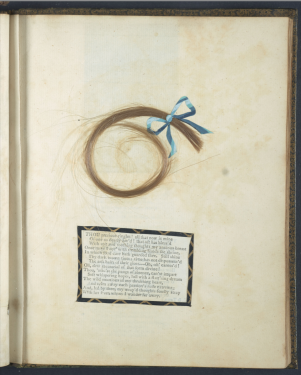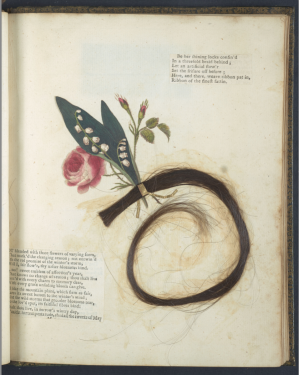Catharine Gould Scrapbook: Difference between revisions
| Line 52: | Line 52: | ||
==Authorship & Copyright== | ==Authorship & Copyright== | ||
[[File:Refashioning.png|thumb| | [[File:Refashioning.png|thumb|200px|left|description]] | ||
Upon close examination of the poems in the scrapbook, it is interesting to note that most do not credit an author or include a title, and almost none reference the date or source publication. While this might seem strange to modern readers, it is common for scrapbookers in the eighteen century to “circumvent publishing, bypass copyrights, and freely cannibalize printed sources."<ref name="Tucker">Susan Tucker, Katherine Ott, and Patricia Buckler, "An Introduction to the History of Scrapbooks," introduction to The Scrapbook In American Life (Philadelphia: Temple University Press, 2006).</ref> In particular, it is important to note that the Statue of Anne introduced the first copyright law in the world not long before the making of this particular scrapbook, so the concept of the copyright is still nascent and not well defined.<ref name="Borsuk">Amaranth Borsuk, The Book | Upon close examination of the poems in the scrapbook, it is interesting to note that most do not credit an author or include a title, and almost none reference the date or source publication. While this might seem strange to modern readers, it is common for scrapbookers in the eighteen century to “circumvent publishing, bypass copyrights, and freely cannibalize printed sources."<ref name="Tucker">Susan Tucker, Katherine Ott, and Patricia Buckler, "An Introduction to the History of Scrapbooks," introduction to The Scrapbook In American Life (Philadelphia: Temple University Press, 2006).</ref> In particular, it is important to note that the Statue of Anne introduced the first copyright law in the world not long before the making of this particular scrapbook, so the concept of the copyright is still nascent and not well defined.<ref name="Borsuk">Amaranth Borsuk, The Book | ||
Revision as of 22:04, 27 April 2022
Introduction
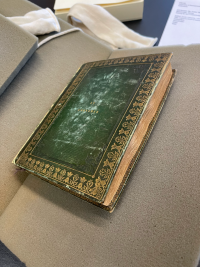
Tucked away in the corners of archives and special collection libraries are a number of old, handmade books that have baffled historians for decades.[1] These books are often hidden under the guise of many names: scrapbooks, albums, commonplace books, blank books. Because these books were never published or circulated in the public sphere, they do not follow the rules and conventions that govern other printed books, providing little information about their production and making it difficult to catalog and understand. At the same time, because of their idiosyncratic and personal nature, these books provide readers with a fascinating glimpse into the inner lives of their makers, offering a snapshot of reading practices at the time of their making.
One such book is Ms. Codex 1860, otherwise cataloged as the Catharine Gould scrapbook, in the Kislak Center for Special Collections, Rare Books and Manuscripts at the University of Pennsylvania. Less than one inch thick, the book is case-bound in lavish green leather and adorned with gold engravings. Inside we find clipped and pasted published poems and images along with a number of handiworks, including handwritten notes, hand drawings and paintings, feathers, pressed flowers and leaves, and locks of hair. Though unusual to modern readers, these items are quite popular and are found in other well-documented historical scrapbooks like Elizabeth Reynolds's A Medley, Anne Wagner's Memorials of Friendship, and the Elizabeth Reynolds scrapbook.[1]
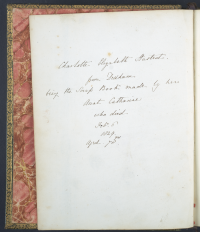
Penn Libraries purchased the book at a 2017 auction at Cheffins, in Cambridge, United Kingdom with the assistance from the Zachs-Adams Rare Book Fund, and it has since remained in the stacks.[2] While the long history of how the book ended up at the auction remains somewhat shrouded in mystery, we could trace its provenance to a woman named Catharine Gould, who lived in Essex County in England from 1751 to 1829. There are no traces of her presence online aside from a will in which she bequeathed her manuscript books to her niece.[3] Indeed, the first page of the scrapbook reads, "Charlotte Elizabeth Hasted from Dedham being the scrapbook made by her Aunt Catharine who died Feb. 6, 1829, aged 78 yrs.”
Even though there is little else we know about this particular book, the note itself provides us with abundant information to begin our investigation of it. The note not only identifies it as a scrapbook, but situates us in England in the late seventeenth and early eighteenth century during the proliferation of print. Drawing from this information, let us now delve deeper to explore the Catharine Gould scrapbook and its personal, cultural, and historical significance.
History & Genre
It is difficult to place handmade books into genres because each book is different and the categories are changing as we speak. But because the writing on the front page identifies the book as a scrapbook, we might first consider it in light of the scrapbook genre. The Oxford English Dictionary records the first official use of the term “scrapbook” in 1825, though it has appeared in private documents like the 1817 Elizabeth Reynolds scrapbook, which contains similar materials as as the Catharine Gould scrapbook like feathers and watercolor paintings.[4] The general consensus is that the term scrapbook refers to books with contents have been cut and pasted in from other sources.[1]
While the term scrapbook is new to the seventeenth century, the notion of cutting and pasting is not. In fact, the practice is common in the manuscript culture of the commonplace books. Commonplace books are books where the creators write down notable passages from other works and organize them under different categories.[5] We could trace the this practice of collecting and reproducing handwritten passages back to Cicero and Quintilian, who encouraged students to write on an album, the latin word for “white” that would come to refer to a blank tablet and later a blank book.[6]
Even though both commonplace books and scrapbooks involve filling blank books or albums with materials found elsewhere, there is an important distinction: the scrapbook is composed of printed materials. As a result, scrapbooks are often described as an “industrialized and democratized” form of the commonplace books.[5] This is because as print became cheaper, even people who did not write were then able to preserve materials using scissors and glue. Because of the increased ease and access, we began to see a greater number and variety of sources, which is characteristic of scrapbooks as we know it.[5]
"Books of Scraps"
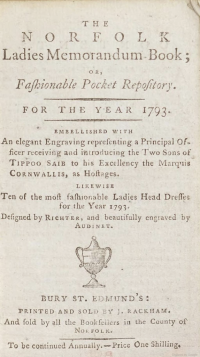
Beside the unique handiworks in the scrapbook, most pages of the scrapbooks are filled with poems that are foreign to most modern readers. These are not the famous poems that we know from eighteenth-century England. Rather, we find an electric mix of unfamiliar charades, enigmas, epigrams, and hymns excerpted from popular, ephemeral publications of the time, few of which are documented in digital repositories. Out of the 100+ poems I studied, I was able to find two publications that match up with the clippings in terms of their content, layout, and typeface: Volume 21 of The London Magazine, Or, Gentleman's Monthly Intelligencer, and The Norfolk Ladies Memorandum Book; Or, Fashionable Pocket Repository For the Year 1793.
This is the norm and not the exception for scrapbooks in this period. In fact, book historian Ellen Gruber Garvey writes that in all the scrapbooks she studied, “all the classics from the eighteenth century were absent.” Rather, we find items from the “cheaper popular circulation” that are opposed to “the more centralized power of prestigious book and magazine publication."[5] In fact, as the practice of scrapbooking became popular, we saw more collections of poems sold as “book of scraps” meant to be cut out rather than read, cherished, and passed on through generations.[7] Therefore, scrapbooks offer the readers a fascinating glimpse to the other side of popular reading culture that we never knew about.
Because these books are ephemeral and sometimes meant to be taken apart, they are often produced with a low budget. We find that most of the poems in the Catharine Gould Scrapbook are printed with a stereotype caste on a thin paper. As a result, some texts are visible on the other side while others are faded or smudged. The papers themselves are also tinted with a blue color, which is reminiscent of the cheap blue books we find for record-keeping. Yet even though these books cost much less than the printed book that we are used, such books were still expensive for most people.[8] Therefore, most women who create scrapbooks come from upper-middle class, and we might speculate the same for Catharine Gould.
Use & Rearrangement
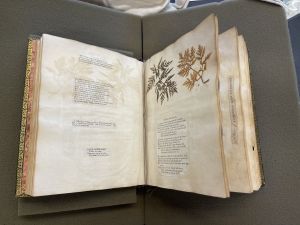
Opening the covers and flipping through the scrapbook, we could see that it was handled on a regular basis. The binding is fragile and some of the green paint is chipping off along the spine to reveal a yellow material underneath. Like all scrapbooks, it was not just read but also made, and we could find marks of its making throughout the pages. For example, the edges are uneven, suggesting that each is hand-cut using scissors albeit with great care. All the items are then pasted into the scrapbook using copious amounts of glue, which crinkles the paper over time and offsets onto the next page to form a faint brown silhouette. There are also spots and streaks of dark brown throughout the scrapbook where glue was swiped or spilled onto the page. More than all other books in the libraries, scrapbooks are perhaps the most transparent in showcasing the human labor behind the pages.
In addition to flipping through and laboring over the scrapbook, the owner also attempted to reorganize and repurpose the book. For example, the items are numbered in the first few pages, but inconsistencies in some of these numbers suggest that items are later rearranged. There are paper stubs throughout the book where two or three pages are cut out. Furthermore, the last few pages contain scribbles of years beginning from 1754, three years after Catharine Gould was born. Because these numbers are written close to the spine, we might deduce that the blank album was first fashioned as an account book for some sort of record keeping, but was taken apart and rebound to form a scrapbook. All these signs highlight that like all handmade books, the Catharine Gould scrapbook is not a static but rather a flexible medium, evolving in tandem with the intentions of the creator.
Readership & Circulation
Even though the scrapbook is designated as the creation of one individual, we might speculate that other people in Catharine Gould’s life also read and contributed to it. It was common for communities of women to collaborate on scrapbooks in seventeenth and eighteen century England.[7] In fact, there are signs that the Catharine Gould scrapbook is the work of many hands. For example, we find different colors of hair and different handwriting in the scrapbook. In addition, women often exchanged scrapbooks as a token of friendship, offered them as gifts on special occasions, or passed them on as heirlooms, which is probable in this case considering the aforementioned note on the first page.[9] Regardless, we might conclude that the scrapbook is intended for someone in the owner’s immediate social circle because it does not contain remarks that offer context clues or illuminate connections between items.[5]
In fact, we might further speculate that the scrapbook is produced as part of a fashionable exercise with scissors work, which was expected of accomplished women of the time.[7] Scholars believe that scrapbooks are often created to show off the taste, learnedness, and artistic abilities of their often female creators.[8] Therefore, we might conclude that the Catharine Gould scrapbook is as much a means of self-expression as an emblem of social status and value.[10] Indeed, there are several features that are more decorative than practical, like the number of thin bookmarks that are not strong enough to withstand multiple uses. In addition, we also find the same poems on different pages, like two identical excerpts from an untitled poem on pages 82 and page 85. These duplicates suggest that the creator purchased multiple copies of the same publication to fill the pages, perhaps to create a pleasing aesthetic. Therefore, we might conclude that the scrapbook is intended less for personal reading but rather for social exhibition.
-
The Prologue to the King's Majesty
-
The Persons of the Play and The Induction of the Stage
Authorship & Copyright
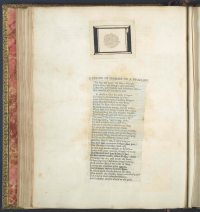
Upon close examination of the poems in the scrapbook, it is interesting to note that most do not credit an author or include a title, and almost none reference the date or source publication. While this might seem strange to modern readers, it is common for scrapbookers in the eighteen century to “circumvent publishing, bypass copyrights, and freely cannibalize printed sources."[6] In particular, it is important to note that the Statue of Anne introduced the first copyright law in the world not long before the making of this particular scrapbook, so the concept of the copyright is still nascent and not well defined.[11] As a result, publishers did not find themselves obligated to cite the source of their poems. In fact, it is characteristic of newspapers and magazines at the time to reprint materials from one another without credit.[5]
In addition to the lack of authorial attributions, texts are often taken out of their original contexts, excerpted from a longer poem, and altered in some fashion. One example is the poem “A String of Similes on a Swallow” on page 156, which was cut out into pieces and then rearranged, so that different sections of the poem are not connected. Another interesting example is that the wording in the poem “charade” on page 32 is changed. Finally, the poem “On Childhood” on pages 43 and 231 is attributed to someone of the initials I. K. when all the digital records suggest that George Coleridge wrote the poem. Together, these instances suggest that the scrapbooker did not see published poems as inviolable works to be preserved in their original form, but as an experimental medium to exercise her own creative intentions.
Impact & Significance
Even though scrapbooks are often difficult to decode at first glance, they provide us with important information that we are not able to find in other published books. For example, the Catharine Gould scrapbook demonstrates the vast amount of ephemeral materials that women read in the seventeenth and eighteenth centuries, almost all of which are lost to time. These scrapbooks show how women during this time passed their leisure time and left their mark on the page, telling their stories through the words of other, often unnamed poets and writers. In fact, scholars agree that “processes of reuse and remediation” that these women facilitated are integral to the “emergence of the mass print culture."[10]
In the larger picture, the Catharine Could Scrapbook also provides a glimpse into how the scrapbook genre has revolutionized our interactions with books, for better or for worse. For example, scrapbooks changed reading from a passive to an active exercise, encouraging people of all backgrounds to intervene in the text and remediate it through their interpretations. In addition, the emergence and propagation of scrapbooks mark the notable shift in the eighteenth century when reading changed from the ‘intensive’ study of a few texts to a broad survey of many texts.[8] In the face of information overload from the mass volume of printed materials, scrapbooks provide readers of the time with the means to distill the materials and preserve the ones that are most meaningful to them.
While scrapbooks are important to the history of books and reading, they are not a thing of the past. In fact, the twenty-first century saw a renewed interest in scrapbooks as it became easier to find and print different items online.[6] We also find legacies of the scrapbook in all walks of our digital lives. For example, the “cut and paste” functions of computer programs reflect the long tradition of scrapbooks and scrapbook making.[5] In particular, with its curated collection of aesthetic images and poems, the Catharine Gould scrapbook is reminiscent of a Pinterest board. All these marks are a testament to the enduring impact that scrapbooks have on our mass media culture in the past, the present, and the future.
References
- ↑ 1.0 1.1 1.2 Deidre Lynch, "Paper Slips: Album, Archiving, Accident," Studies in Romanticism 57, no. 1 (2018): https://proxy.library.upenn.edu/login?url=https://www.proquest.com/scholarly-journals/paper-slips-album-archiving-accident/docview/2061875748/se-2?accountid=14707.
- ↑ "Catharine Gould Scrapbook," Philadelphia Area Archives Research Portal, http://dla.library.upenn.edu/dla/pacscl/detail.html?id=PACSCL_UPENN_RBML_PUSpMsCodex1890.
- ↑ "Will of Catharine Gould, Spinster of Dedham, Essex," The National Archive, https://discovery.nationalarchives.gov.uk/details/r/D259435.
- ↑ "Scrapbook," Oxford English Dictionary, https://www.oed.com/view/Entry/173320?rskey=2ApOj1&result=1&isAdvanced=false#eid.
- ↑ 5.0 5.1 5.2 5.3 5.4 5.5 5.6 Ellen Gruber Garvey, Writing with Scissors (Oxford: Oxford University Press, 2012), https://oxford-universitypressscholarship-com.proxy.library.upenn.edu/view/10.1093/acprof:oso/9780195390346.001.0001/acprof-9780195390346.
- ↑ 6.0 6.1 6.2 Susan Tucker, Katherine Ott, and Patricia Buckler, "An Introduction to the History of Scrapbooks," introduction to The Scrapbook In American Life (Philadelphia: Temple University Press, 2006).
- ↑ 7.0 7.1 7.2 Deidre Lynch, "Wedded to Books: Nineteenth Century Bookmen at Home," in Loving Literature: A Cultural History (Chicago: University of Chicago Press, 2014), https://doi-org.proxy.library.upenn.edu/10.7208/9780226183848.
- ↑ 8.0 8.1 8.2 Stephen Colclough, Consuming Texts: Readers and Reading Communities, 1695-1870 (London: Palgrave Macmillan, 2007).
- ↑ Tim Somers, Ephemeral Print Culture in Early Modern England: Sociability, Politics and Collecting (Rochester: Boydell Press, 2021)
- ↑ 10.0 10.1 Alexis Easley, "Scrapbooks and Women's Leisure Reading Practices, 1825–60," Nineteenth-Century Gender Studies 15, no. 2 (2019), https://proxy.library.upenn.edu/login?url=https://www.proquest.com/scholarly-journals/scrapbooks-women-s-leisure-reading-practices-1825/docview/2587889165/se-2?accountid=14707.
- ↑ Amaranth Borsuk, The Book (Massachusetts: MIT Press, 2018).
